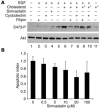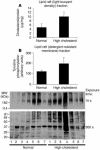Cholesterol targeting alters lipid raft composition and cell survival in prostate cancer cells and xenografts
- PMID: 15776112
- PMCID: PMC1064980
- DOI: 10.1172/JCI19935
Cholesterol targeting alters lipid raft composition and cell survival in prostate cancer cells and xenografts
Abstract
Lipid rafts are cholesterol- and sphingolipid-enriched microdomains in cell membranes that regulate phosphorylation cascades originating from membrane-bound proteins. In this study, we tested whether alteration of the cholesterol content of lipid rafts in prostate cancer (PCa) cell membranes affects cell survival mechanisms in vitro and in vivo. Simvastatin, a cholesterol synthesis inhibitor, lowered raft cholesterol content, inhibited Akt1 serine-threonine kinase (protein kinase Balpha)/protein kinase B (Akt/PKB) pathway signaling, and induced apoptosis in caveolin- and PTEN-negative LNCaP PCa cells. Replenishing cell membranes with cholesterol reversed these inhibitory and apoptotic effects. Cholesterol also potentiated Akt activation in normal prostate epithelial cells, which were resistant to the apoptotic effects of simvastatin. Elevation of circulating cholesterol in SCID mice increased the cholesterol content and the extent of protein tyrosine phosphorylation in lipid rafts isolated from LNCaP/sHB xenograft tumors. Cholesterol elevation also promoted tumor growth, increased phosphorylation of Akt, and reduced apoptosis in the xenografts. Our results implicate membrane cholesterol in Akt signaling in both normal and malignant cells and provide evidence that PCa cells can become dependent on a cholesterol-regulated Akt pathway for cell survival.
Figures







Similar articles
-
Membrane rafts segregate pro- from anti-apoptotic insulin-like growth factor-I receptor signaling in colon carcinoma cells stimulated by members of the tumor necrosis factor superfamily.Am J Pathol. 2005 Sep;167(3):761-73. doi: 10.1016/S0002-9440(10)62049-4. Am J Pathol. 2005. PMID: 16127155 Free PMC article.
-
Cholesterol-rich lipid rafts mediate akt-regulated survival in prostate cancer cells.Cancer Res. 2002 Apr 15;62(8):2227-31. Cancer Res. 2002. PMID: 11956073
-
Cholesterol sensitivity of endogenous and myristoylated Akt.Cancer Res. 2007 Jul 1;67(13):6238-46. doi: 10.1158/0008-5472.CAN-07-0288. Cancer Res. 2007. PMID: 17616681
-
The integrity of cholesterol-enriched microdomains is essential for the constitutive high activity of protein kinase B in tumour cells.Biochem Soc Trans. 2004 Nov;32(Pt 5):837-9. doi: 10.1042/BST0320837. Biochem Soc Trans. 2004. PMID: 15494028 Review.
-
Lipid rafts as major platforms for signaling regulation in cancer.Adv Biol Regul. 2015 Jan;57:130-46. doi: 10.1016/j.jbior.2014.10.003. Epub 2014 Oct 27. Adv Biol Regul. 2015. PMID: 25465296 Review.
Cited by
-
Lipid composition of the cancer cell membrane.J Bioenerg Biomembr. 2020 Oct;52(5):321-342. doi: 10.1007/s10863-020-09846-4. Epub 2020 Jul 26. J Bioenerg Biomembr. 2020. PMID: 32715369 Free PMC article. Review.
-
Lovastatin enhances adenovirus-mediated TRAIL induced apoptosis by depleting cholesterol of lipid rafts and affecting CAR and death receptor expression of prostate cancer cells.Oncotarget. 2015 Feb 20;6(5):3055-70. doi: 10.18632/oncotarget.3073. Oncotarget. 2015. PMID: 25605010 Free PMC article.
-
The effect of lowering cholesterol through diet on serum prostate-specific antigen levels: A secondary analysis of clinical trials.Can Urol Assoc J. 2022 Aug;16(8):279-282. doi: 10.5489/cuaj.7975. Can Urol Assoc J. 2022. PMID: 35905298 Free PMC article.
-
Fasting inhibits aerobic glycolysis and proliferation in colorectal cancer via the Fdft1-mediated AKT/mTOR/HIF1α pathway suppression.Nat Commun. 2020 Apr 20;11(1):1869. doi: 10.1038/s41467-020-15795-8. Nat Commun. 2020. PMID: 32313017 Free PMC article.
-
Impaired cholesterol biosynthesis in a neuronal cell line persistently infected with measles virus.J Virol. 2009 Jun;83(11):5495-504. doi: 10.1128/JVI.01880-08. Epub 2009 Mar 18. J Virol. 2009. PMID: 19297498 Free PMC article.
References
-
- Pike LJ. Lipid rafts: bringing order to chaos. J. Lipid Res. 2003;44:655–667. - PubMed
-
- Deurs B, Roepstorff K, Hommelgaard AM, Sandvig K. Caveolae: anchored, multifunctional platforms in the lipid ocean. Trends Cell Biol. 2003;13:92–100. - PubMed
-
- Drab M, et al. Loss of caveolae, vascular dysfunction, and pulmonary defects in caveolin-1 gene-disrupted mice. Science. 2001;293:2449–2452. - PubMed
-
- Liu P, Rudick M, Anderson RG. Multiple functions of caveolin-1. J. Biol. Chem. 2002;277:41295–41298. - PubMed
Publication types
MeSH terms
Substances
Grants and funding
LinkOut - more resources
Full Text Sources
Other Literature Sources
Medical
Research Materials
Miscellaneous

